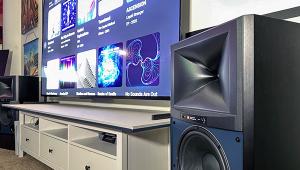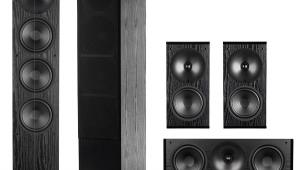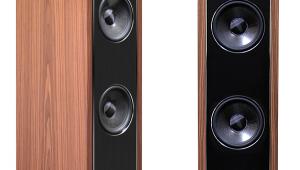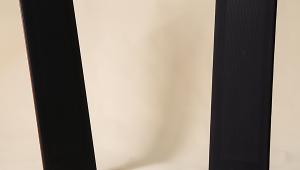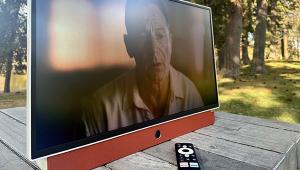Infinity Cascade Speaker System
 The Cascade system relies on small, svelte front, center and surround speakers, plus a cleverly camouflaged subwoofer to provide low frequencies. That allows the system to be used in a home theater or, perhaps, in a family room. No monster front-channel speakers dominate the room. It is a formula I have come to like, assuming the components perform well.
The Cascade system relies on small, svelte front, center and surround speakers, plus a cleverly camouflaged subwoofer to provide low frequencies. That allows the system to be used in a home theater or, perhaps, in a family room. No monster front-channel speakers dominate the room. It is a formula I have come to like, assuming the components perform well.
I have long been an admirer of Infinity speakers. I bought my first pair while in college, floor-standing speakers with 12" woofers, a midrange of a size and type I cannot recall, and delightful electrostatic tweeters. They were my first significant speakers (not counting the Dynaco A25s I had in high school) and I kept them until I was stationed in a foreign country where my voltage converter failed, frying the tweeters.
More recently I have owned an Infinity Prelude system, purchased in 1997; I replaced it about five years ago with an Infinity MTS Prelude system. That remains my reference standard and is a traditional system with two large front speakers, each with a built-in 12" powered subwoofer. For years these speakers have been Infinity's top-of-the-line home theater speakers. But because of the high cost of manufacturing them, the Preludes were recently discontinued. For now, at least, the Cascades are Infinity's top-of-the line speakers, at a retail cost of $5,894 for a 5.1-channel system I tested.
In some ways, these speakers are heirs to the electrostatic speakers I owned in my "audiophile" youth. With the exception of the subwoofer, the speakers do not have traditional cone drivers. Infinity's acknowledged goal was to make "thin" speakers for appearance's sake, and at that the company has succeeded. The left and right front-channel speakers in the review system are only about 6" deep, and 47" tall mounted atop their custom, aluminum colored stands. They are modest but handsome in the cherry veneer finish of my review samples.
The speakers use conventional magnetic-coil motor technology with a new, flat-panel driver that is less than two inches deep. Infinity claims that it combines "the best of both technologies," old-style electrostatic and conventional, moving-coil, cone speakers. It strikes me, however, that these are simply conventional speakers with flat diaphragms (see "Technology and Measurements" for more details).
In my review system, the front-channel, Model Nine speakers ($999 each) have two flat-panel bass-midrange drivers and one tweeter. The Model Sevens ($799 each), used here as surrounds but also suitable for front channel use, have the same tweeter but only one of the bass-mid drivers.

The Model 15 subwoofer ($1,499), a heavy number with an 800-watt amplifier, is wholly traditional in design, though not in shape. It features four 6" x 6" square drivers and comes with the R.A.B.O.S. (Room Adaptive Bass Optimization System) frequency adjustment kit that allows you to tailor the woofers' output a bit to fit the parameters of your room#151;a feature borrowed from the larger Prelude system. The speakers face the floor, so what you see is a broad, horizontal expanse of cabinet that looks (as TJN remarked) like a radiator - the kind that produces heat.
Setup
One small bit of poor planning on Infinity's part: the instruction booklet for each speaker lays on the top of the speaker's packaging, just under the slit between the flaps of the taped-closed box. So when I dragged a razor knife down the slit to open the box, not surprisingly I sliced right through the instruction book—as I saw when I pulled the box open. That was the only real setup mishap I experienced.
The speaker stands are packed alongside the speakers. Together they are one design piece, and the speakers slide onto them with no trouble (or fastening bolts). I placed them directly in front of my existing speakers so that the room setup/calibration locked into my Lexicon processor would work for these as well.
The R.A.B.O.S. subwoofer calibration system involves playing test tones through your system using a provided CD (that also explains the process and guides you through it) as you watch a sound meter (also provided). You adjust the sub's output level controls to smooth out peaks and dips. It helps but is not perfect, as the speaker does not offer a graphic equalizer type control, just a broad bass-level dial. That does not help very much if your room induces, for example, a valley in a specific frequency range. Still, it does make a difference. As it happens, the subwoofer performed quite well in the location I gave it#151;near a corner but not in it#151;and did not require much adjustment. The crossover was set at 80 Hz.
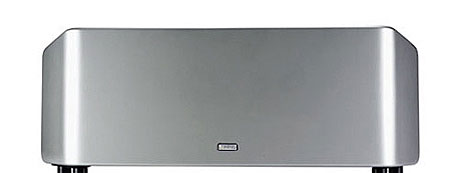
Placing the other five speakers was not problematic, given their small, thin frames. The Model Nines allow bi-wiring, letting you use a different amplifier for the midrange speakers and the tweeter. For speakers of this type that did not seem particularly useful, and almost a bit pretentious.
Performance
I listened to some SACDs to begin with, two-channel and multichannel discs, and immediately found these speakers to be quite capable. Despite their small frames, they were also able to produce near-ear shattering volumes without distortion or strain. My first broad reaction, one that held up through two weeks of use, was that the subwoofer was quite good, but the tweeters on the main speakers sounded subdued.
The sub produced authoritative bass that was quite tight and controlled, as you would expect from four 6" drivers. Drums and other low frequency instruments were portrayed without any flab. The subs spoke with accuracy and authority that was quite pleasing. Still, as you might also expect from 6" drivers, the sub was not able to reach down and reproduce the deepest bass. In fact, the R.A.B.O.S. calibration disc showed that the sub began to drop off at about 45 Hz and was producing no useful sound at 35 Hz.
The larger, Prelude MTS system, with 12" woofers, can produce bass on a smooth line all the way down to 20 Hz, the floor of human hearing. But then I have to cede a credit to the Cascades. The 6" subs produced bass that was a bit tighter, more precise.
The tweeter, well, it just did not seem capable of keeping up with the rest of the system. I always have to check myself when evaluating very-high frequency effects. All of us simply lose the ability to hear high frequencies as we age. So to check myself, I rewired the Prelude MTS channel for the right speaker and then played several discs in mono and used the balance to move from the left to the right. The Prelude was notably better at producing high frequencies that seemed in balance with the rest of the audio spectrum.
This left-right balance approach also enabled me to place the Cascades in a broader perspective. How did what I heard compare with Cascades' older and more expensive cousins? Infinity's advertising literature portrays the Cascades as heirs to the Preludes. But then, the Prelude system, before it was discontinued, sold for $16,000 - nearly three times the cost of the Cascades.
 With that imbalance in mind, I found the Cascades lacked the crystal clarity in the midrange that the Preludes offered. They sounded a bit inarticulate#151;muddy. The distinction between two instruments of the same pitch was less distinct. I'd had the impression, before this comparison, that the Cascades midrange was providing a bit less clarity than I was used to. The comparison with my reference Preludes bore that point home.
With that imbalance in mind, I found the Cascades lacked the crystal clarity in the midrange that the Preludes offered. They sounded a bit inarticulate#151;muddy. The distinction between two instruments of the same pitch was less distinct. I'd had the impression, before this comparison, that the Cascades midrange was providing a bit less clarity than I was used to. The comparison with my reference Preludes bore that point home.
Nonetheless, do not forget that the Cascades are far less expensive than the Preludes. And don't overlook their clear asset—the Cascades can slip into a room barely noticed while bringing in the Preludes is like parking a pair of pickup trucks in your living room.
I watched several movies with the Preludes, first among them The Transporter, an action movie with lots of screeching tires, explosions and the like. The Cascades handled it beautifully - except for one thing. I could barely distinguish the dialog from music, explosions and audio mayhem. Was this soundtrack embodiment of the "muddy midrange" problem? Was the center channel out of balance? None of the above. I rewired the Preludes and experienced exactly the same problem, though perhaps not quite as extreme. This was a problem with the soundtrack. Acutely aware of the potential problem, I did not hear any evidence of it with any other DVD.
Over two weeks of use, I watched half a dozen different movies of different types - some with lots of violence, others offering subtlety, and the Cascades never let me down. I actually looked forward to the precision of the woofer each time it came into play, and the speakers' ability to play loud—as I like to listen to my movies—was also most impressive.
Conclusion
Infinity invested a lot in creating these speakers for the new home theater environment made possible by plasma and other thin-form TVs. Home theaters are moving out of the basement, into the living room, and the largest hurdle toward successfully incorporating all this equipment in a public room with other purposes is now finding space for the speakers. The Cascades come close to solving that problem without significant compromise. You can't help but enjoy them.
Highs and Lows
Highs
Excellent subwoofer
Attractive design
Lows
Subdued highs
Midrange clarity not equal to previous Infinity flagship designs
- Log in or register to post comments




